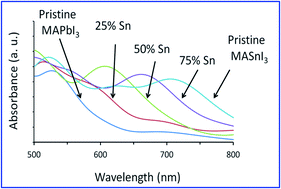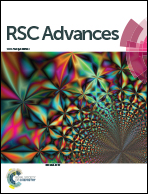Substitution induced band structure shape tuning in hybrid perovskites (CH3NH3Pb1−xSnxI3) for efficient solar cell applications
Abstract
Organic–inorganic hybrid perovskite compounds such as CH3NH3PbI3 hold a great potential for low cost photovoltaic devices. Though CH3NH3PbI3 possesses fundamental properties favorable for solar energy harvesting, environmentally safe materials with higher energy efficiency are needed for practical applications. Replacement of lead by tin is a promising solution and investigating the fundamental properties of lead and tin mixed halides is essential. In this article, we have reported electronic and optical properties by employing Density Functional Theory based first principles calculations of Sn doped methyl ammonium lead halide, CH3NH3Pb1−xSnxI3 (x = 0, 0.25, 0.5, 0.75, 1.0). Our results reveal that tin doping narrows the optical band gap allowing absorption of visible light up to 850 nm. Tin doping at Pb sites primarily affects the composition and nature of the valence band maximum. Tin 5p induced electronic states are highly delocalized in nature and are likely to improve the mobility and possible exciton diffusion lengths of holes. Based on the results of this study, 50% Sn doping could to be useful for enhanced performance of perovskite based photovoltaics.


 Please wait while we load your content...
Please wait while we load your content...